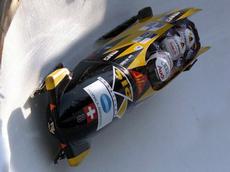The Science behind bobsleigh
The Swiss Bobsleigh, Luge and Skeleton Federation has teamed with several industrial partners to construct the winning bobsleigh for the Vancouver 2010 Olympics. CITIUS, a project launched in 2007, has clear goals and a tight time schedule. At the recently held “Challenge Event”, all sides were highly committed and imaginative.

CITIUS is derived from the motto of the modern-day Olympics used since 1894: “CITIUS, ALTIUS, FORTIUS” – faster, higher, stronger. But Swiss athletes do not only want to be faster, they want to be the fastest. The target of the around 20 scientists and developers is to construct the winning bobsleigh, both for the two-man and the four-man competitions.
There is more to it than technology
For the first time, athletes participated in the half-yearly meeting of the research scientists and their industrial partners. Their suggestions and concerns were met with interest and taken seriously by the research scientists, who tried to incorporate all their wishes and ideas. But once more it became apparent that it is mainly team spirit and not the material alone that decides victory. The initial pushing and momentum of the bobsleigh is just as essential as is its construction and steering in a sport in which winners and losers are separated by only hundredths of a second.
The project is headed by Robert Fürer, of Fürer Partner Advocaten, while the product development is divided into different sub-groups. The coordination and management of the different sub-projects between science and industry is in the hands of Christian Reich, an experienced bobsleigh designer and one of the most successful pilots between 1997 and 2002, and Ulrich Suter, Professor at the Department of Materials at the ETH Zurich. Specific problems regarding the runners, kinetics and aerodynamics are dealt with by the responsible research specialists within the respective projects.
The teams of Nicholas Spenser and Pavel Hora, both professors at the Department of Materials and the Institute of Mechanical Systems, are responsible for the runners. In cooperation with the companies sia abrasives, GK Formenbau AG and Indrohag they focus on with the shape of the runners and the performance properties of their surface. This process has always to be carried out in strict accordance with the technical limitations of the FIBT (International Bobsleigh and Tobogganing Federation). These specifications apply to the overall structure and design of a bobsleigh. The makers of the runners, for example, have to adhere to a precisely defined steel that is only allowed to be processed within narrow limits. The research scientists and developers aim to get maximum results from the pre-determined parameters. It is therefore essential to fully explore the exact functioning of the gliding and steering properties and the interaction between ice and runners. The runners, for example, should be constructed in such way that enables a film of melted ice to be formed as quickly as possible in order to minimize frictional resistance.
Light but yet stable
The teams for kinematics under Christoph Glocker and Paolo Ermanni, both Professors at the Institute for Mechanical Systems, are in close cooperation with the Swiss Bobsleigh, Luge and Skeleton Federation, and with the companies Bucher-Guyer, Quadrant, Sika and Indrohag. They are therefore responsible for searching for appropriate materials and for bringing the bobsleigh with steel undercarriage and chassis into one optimum and complete system. One of the two challenges facing the kinematics teams is to construct a shell that is both light and stable. In this way it should be possible for speeds of well over 150 km/h to be attained on the approximately 1500 meter Olympic bob run “Whistler” in Vancouver. According to Christian Reich, two accidents happened last season on the Whistler bob run, in which one bobsleigh was completely destroyed.
The aerodynamics team led by Patrick Jenni, Professor at the Institute of Fluid Dynamics at the ETH Zurich is seeking jointly with its industrial partners to minimize the frictional resistance of the bobsleigh to the maximum. They used the findings and results gathered in numerous runs in St. Moritz. The air flow was monitored and reconstructed with the aid of simple woolen threads. Computer simulations on the basis of the data won showed the main aerodynamic friction originates at the nose of the bobsleigh and from the pilot’s helmet. It is here that the shell and its design can be optimized, but here, too, only within the narrow limits defined by the FIBT.
The countdown is running
Thomas Kern from one of the kinematics teams presented the master plan at the Challenge Event, and stated that “the 2010 Olympic Games will start in exactly 690 days – little time for such an ambitious project”. Within this time frame, not only the fastest and most reliable bobsleighs have to built, which not only have to convince the athletes, but will also have to win their trust. In spite of the tight timetable, both factors seem to point in the right direction.
Links and references:







READER COMMENTS